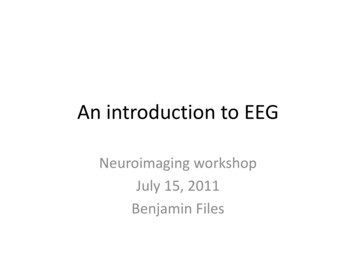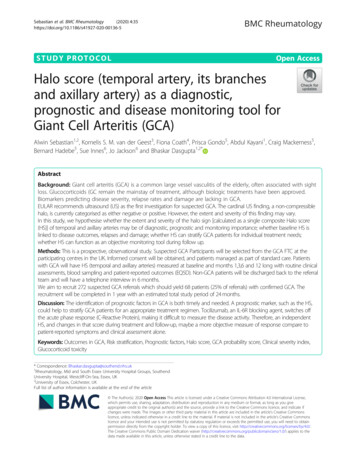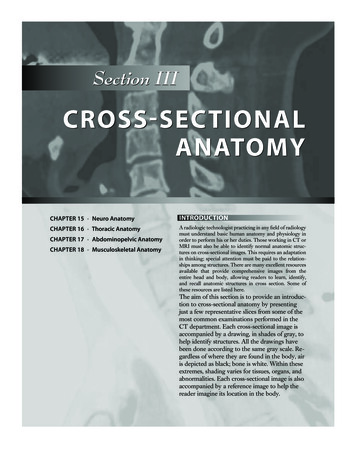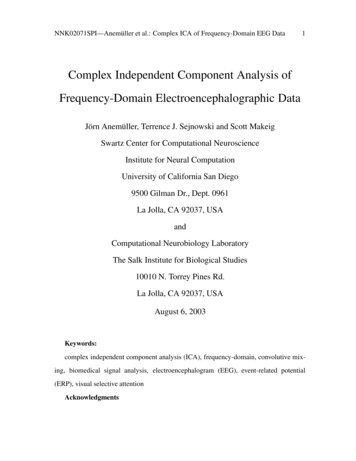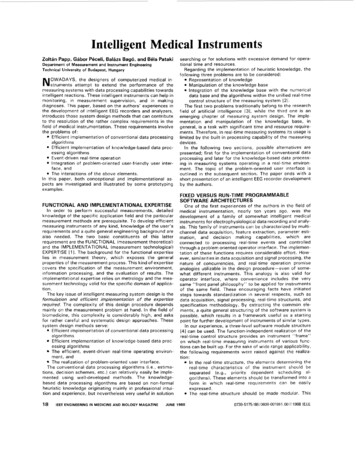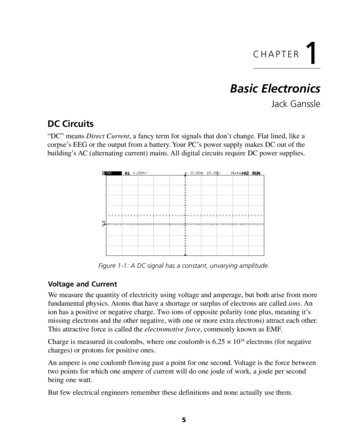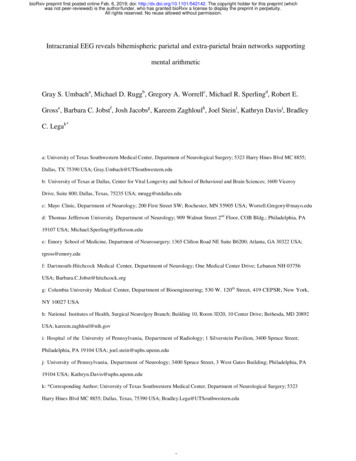
Transcription
bioRxiv preprint first posted online Feb. 6, 2019; doi: http://dx.doi.org/10.1101/542142. The copyright holder for this preprint (whichwas not peer-reviewed) is the author/funder, who has granted bioRxiv a license to display the preprint in perpetuity.All rights reserved. No reuse allowed without permission.Intracranial EEG reveals bihemispheric parietal and extra-parietal brain networks supportingmental arithmeticGray S. Umbacha, Michael D. Ruggb, Gregory A. Worrellc, Michael R. Sperlingd, Robert E.Grosse, Barbara C. Jobstf, Josh Jacobsg, Kareem Zaghloulh, Joel Steini, Kathryn Davisj, BradleyC. Legak*a: University of Texas Southwestern Medical Center, Department of Neurological Surgery; 5323 Harry Hines Blvd MC 8855;Dallas, TX 75390 USA; Gray.Umbach@UTSouthwestern.edub: University of Texas at Dallas, Center for Vital Longevity and School of Behavioral and Brain Sciences; 1600 ViceroyDrive, Suite 800; Dallas, Texas, 75235 USA; mrugg@utdallas.educ: Mayo Clinic, Department of Neurology; 200 First Street SW; Rochester, MN 55905 USA; Worrell.Gregory@mayo.edud: Thomas Jefferson University, Department of Neurology; 909 Walnut Street 2nd Floor, COB Bldg.; Philadelphia, PA19107 USA; Michael.Sperling@jefferson.edue: Emory School of Medicine, Department of Neurosurgery; 1365 Clifton Road NE Suite B6200; Atlanta, GA 30322 USA;rgross@emory.eduf: Dartmouth-Hitchcock Medical Center, Department of Neurology; One Medical Center Drive; Lebanon NH 03756USA; Barbara.C.Jobst@hitchcock.orgg: Columbia University Medical Center, Department of Bioengineering; 530 W. 120th Street, 419 CEPSR; New York,NY 10027 USAh: National Institutes of Health, Surgical Neurolgoy Branch; Building 10, Room 3D20, 10 Center Drive; Bethesda, MD 20892USA; kareem.zaghloul@nih.govi: Hospital of the University of Pennsylvania, Department of Radiology; 1 Silverstein Pavilion, 3400 Spruce Street;Philadelphia, PA 19104 USA; joel.stein@uphs.upenn.eduj: University of Pennsylvania, Department of Neurology; 3400 Spruce Street, 3 West Gates Building; Philadelphia, PA19104 USA; Kathryn.Davis@uphs.upenn.eduk: *Corresponding Author; University of Texas Southwestern Medical Center, Department of Neurological Surgery; 5323Harry Hines Blvd MC 8855; Dallas, Texas, 75390 USA; Bradley.Lega@UTSouthwestern.edu1
bioRxiv preprint first posted online Feb. 6, 2019; doi: http://dx.doi.org/10.1101/542142. The copyright holder for this preprint (whichwas not peer-reviewed) is the author/funder, who has granted bioRxiv a license to display the preprint in perpetuity.All rights reserved. No reuse allowed without permission.AbstractMathematical reasoning is central to everyday life. Lesion data and functional MRIstudies suggest that even simple arithmetic involves the coordination of multiple spatiallydiverse brain regions, but to date, math processing has not been well characterizedusing direct brain recordings, especially outside of the parietal cortex. To address this, weutilized an unparalleled data set of 310 subjects implanted with intracranial electrodes toinvestigate the spatial and temporal dynamics of arithmetic reasoning. Our data supportthe importance of regions previously implicated in numerosity such as the superior parietallobule and intraparietal sulcus. However, we also identify contributions to arithmeticprocessing from regions such as the entorhinal cortex and temporal pole. Using the excellentbihemispheric coverage afforded by our data set and the precise temporal resolution ofintracranial recordings, we characterize in detail the spatial and temporal characteristics of anarithmetic processing network, quantifying subtle hemispheric differences for selected regions.We also examine how activity in these regions predicts arithmetic ability and look for genderdifferences in the pattern of network activation. Our findings further define the complexnetwork of regions involved in human arithmetical reasoning.Keywords: electrophysiology, human cognition, intracranial electroencephalography,mathematics1. IntroductionMathematical processing is a central feature of human cognition, present acrosssocieties and linguistic systems. Its neural bases have been characterized throughnumerous noninvasive imaging and lesion studies. These data have suggested thatmathematical manipulation requires complex interaction among bihemispheric brain2
bioRxiv preprint first posted online Feb. 6, 2019; doi: http://dx.doi.org/10.1101/542142. The copyright holder for this preprint (whichwas not peer-reviewed) is the author/funder, who has granted bioRxiv a license to display the preprint in perpetuity.All rights reserved. No reuse allowed without permission.regions, including understanding of value associated with numerical symbols, semanticmemory of mathematical facts, the manipulation of numerical quantities using an “internalnumber line,” spatial attentional resources, and the manipulation of numerical quantitiesin working memory (Dehaene 1992; Dehaene et al. 2003; Daitch et al. 2016). It isthought that mathematical reasoning depends and even builds upon brain regionsinvolved other cognitive processes such as non-verbal quantity manipulation and fingercounting and as such parietal regions are most active during arithmetical cognition(Berteletti and Booth 2016; Nieder and Dehaene 2009). Central to this proposed parietalcircuitry is the horizontal intraparietal sulcus (HIPS), a region that has exhibited reliableactivation for tasks requiring specific manipulation of quantities, estimation, and equationsolving (Dehaene 1992; Dehaene et al. 1999; Piazza et al. 2004; Dastjerdi et al. 2013;Amalric and Dehaene 2016; Daitch et al. 2016). These data have led some investigatorsto propose that the HIPS is specifically and exclusively active during mathematicalcognition, while dissenting scientists believe it is more generically activated by quantityestimation and manipulation including spatial and other quantities. The HIPS isnecessary but not sufficient for mathematical reasoning, according to the “three parietalcircuits” model proposed by Dehaene (Dehaene et al. 2003). Along with the “internalnumber line” anatomically centered in the HIPS, mathematical tasks also recruit moredorsal parietal regions (superior parietal lobule, precuneus) which are thought to provide anorienting signal for math and spatial tasks as a specific functional domain within widerdorsal attention networks. The SPL however may also support ongoing mathematicalprocessing apart from this initial attention function, as lesions in the SPL can elicit deficitson spatial and numerical bisection tasks (Zorzi et al. 2002). The final contributor to this three-3
bioRxiv preprint first posted online Feb. 6, 2019; doi: http://dx.doi.org/10.1101/542142. The copyright holder for this preprint (whichwas not peer-reviewed) is the author/funder, who has granted bioRxiv a license to display the preprint in perpetuity.All rights reserved. No reuse allowed without permission.circuit model is the angular gyrus, which supports semantic comprehension andrepresentation of the numerical values associated with mathematical symbols (Grabneret al. 2009). A dissociation between angular gyrus and HIPS/SPL activation has beenobserved experimentally using paradigms that distinguish between mathematical factretrieval (simple addition or multiplication of likely memorized equations) and moreconventional numerical processing (such as estimation of quantity) (Dehaene et al. 1999;Grabner et al. 2009). Associated with these parietal circuit is an occipitotemporal regionthought to preferentially activate during numerical item presentation (the putative numberform area, NFA) (Shum et al., 2013).The three parietal regions plus NFA map partially onto a proposed cognitive “divisionof labor” during mathematical processing, by which visual input must be decoded(interpretation of Arabic numeral code NFA), semantic information of mathematicalstatements (especially memorized expressions) must be extracted/interpreted (semanticcode angular gyrus/semantic language regions), and quantities must be representedalong an internal number line and be evaluated and manipulated (HIPS). While thiscombined triple code/parietal circuits model incorporates the most active mathematicalprocessing areas, it is highly likely that other brain regions may contribute as well. Someexamples include the prefrontal cortex, which has been observed to house neurons tunedto specific numerosities in primates (Nieder 2012). For more complex arithmeticalmanipulations, this region may also play a role in working memory maintenance ofintermediate values during equation solving (Curtis and D’Esposito 2003). Likewise, atleast during development, regions of the temporal lobe may participate in semanticrepresentations of mathematical symbols or numbers (Menon 2016), and noninvasive4
bioRxiv preprint first posted online Feb. 6, 2019; doi: http://dx.doi.org/10.1101/542142. The copyright holder for this preprint (whichwas not peer-reviewed) is the author/funder, who has granted bioRxiv a license to display the preprint in perpetuity.All rights reserved. No reuse allowed without permission.studies have observed activation in other regions such as the insula (Simon et al. 2002),implying some correlation of activity in rhinal and limbic networks with arithmeticalprocessing, though a specific role has not been defined for these within a mathprocessing network. Importantly, the involvement of these and other extra-parietalregions in arithmetic has not been characterized using direct brain recordings (Daitch etal. 2016).While there is no evidence for difference in math aptitude between genders (Hyde etal. 2008), a noninvasive imaging study using an arithmetic task demonstrated greateractivation of the right posterior parietal cortex structures in males compared to females(Keller and Menon 2009), suggesting potential divergence of problem-solving strategy.We know of no iEEG study that has explored differences in arithmetic problem-solvingstrategy further.Existing human iEEG studies of arithmetical processing have been limited by inclusionof relatively few subjects, but these investigations have supported the existence ofspecifically numerically sensitive regions in the inferior temporal area and of theimportance of the IPS to arithmetical processing (Daitch et al. 2016; Pinheiro-Chagas etal. 2018). However, several components of the proposed functional-neuroanatomicmodels have not been investigated, such as unilateral versus bilateral activation of theseparietal regions. Further, the exclusive use of subdural grid electrodes in prior studiesprecludes sampling from subcortical locations and the possibility of disambiguatingactivity arising from midline parietal structures (namely the precuneus) from thatgenerated in the dorsal SPL. Depth electrodes also aid in differentiating dorsal midlinestructures like the precuneus, expected to be active in arithmetic (Dehaene et al. 2003),5
bioRxiv preprint first posted online Feb. 6, 2019; doi: http://dx.doi.org/10.1101/542142. The copyright holder for this preprint (whichwas not peer-reviewed) is the author/funder, who has granted bioRxiv a license to display the preprint in perpetuity.All rights reserved. No reuse allowed without permission.from contributions of the posterior cingulate cortex, shown to be suppressed duringarithmetic (Foster et al. 2012). Finally, the possible participation of brain regions in anarithmetic processing network outside of the ventral temporoparietal cortex has not beeninvestigated using direct brain recordings, in spite of extensive functional imagingevidence indicating that other brain regions (especially the pre-frontal cortex and insula)exhibit mathematics related activation. Support for the importance of direct recordings tocharacterize arithmetical processing regions has come from a recent electrophysiologystudy indicating that the temporal dynamics of activation in some brain regions mayrender the activity undetectable to analyses based solely upon BOLD signal changes(Pinheiro-Chagas et al. 2018).To address these gaps in the literature surrounding electrophysiological activityunderlying arithmetical processing in humans, we analyzed an unparalleled data set of310 subjects who performed an arithmetical task during monitoring with intracranialelectrodes for seizure mapping. We identified a core arithmetical processing network byidentifying brain locations that show significantly greater activity during arithmeticalreasoning as compared to successful episodic memory encoding. The advantage of thiscomparison condition is that we are able to reduce the influence of nonspecific taskrelated activity in the brain (such as that associated with focusing of attention), althoughthis paradigm may underestimate the contribution brain areas involved in retrieval ofsemantic facts (see discussion). In addition, our data set included over 50 subjects withparietal cortex depth electrodes inserted via the stereo EEG technique, allowing us toobtain signal directly from the IPS and to disambiguate the contributions to arithmeticalprocessing of dorsal SPL locations from those of midline parietal areas (precuneus and6
bioRxiv preprint first posted online Feb. 6, 2019; doi: http://dx.doi.org/10.1101/542142. The copyright holder for this preprint (whichwas not peer-reviewed) is the author/funder, who has granted bioRxiv a license to display the preprint in perpetuity.All rights reserved. No reuse allowed without permission.posterior cingulate). Using direct brain recordings, we were able to explore in detail temporaldynamics within a core arithmetic processing network as well as how these temporalpatterns differed across the hemispheres. The large number of participants allowed usto examine how activity within regions predicted math performance, and also to lookfor gender-related differences in processing patterns.2. Methods2.1 ParticipantsA total of 310 adult patients were consented to contribute to the study. Patients wererecruited as part of a national research consortium for the investigation of memoryprocessing (DARPA RAM program) as well as through iEEG studies conductedindependently by this program at UT Southwestern and the University of Pennsylvania.Patient characteristics including handedness and hemispheric dominance wereassessed by local clinical experts.2.2 Behavioral taskSubjects performed the free recall task on a laptop computer. The laptop transmitted serialelectrical pulses into the clinical system to allow for alignment of behavioral events tothe corresponding iEEG data. Several variations of this task provided data for thisanalysis, with minor differences in the total number of memory items and categoricalstructure of the study list. However, the arithmetic component of these tasks was identicalacross all variants of the recall procedure. In all cases, subjects were presented with aseries of words for later recall. All the words of a list (12-15 items) were capitalized anddisplayed at the center of the screen for 1600 ms. Each word was followed by an 400-600ms inter-stimulus interval during which there was no stimulus on the screen. After the7
bioRxiv preprint first posted online Feb. 6, 2019; doi: http://dx.doi.org/10.1101/542142. The copyright holder for this preprint (whichwas not peer-reviewed) is the author/funder, who has granted bioRxiv a license to display the preprint in perpetuity.All rights reserved. No reuse allowed without permission.final word, patients immediately engaged in a series of arithmetic problems of the form A B C ? for a minimum duration of 20 seconds, with A, B, and C representingrandomly selected integers ranging from one to nine. Participants entered their answervia the laptop’s keyboard. A new arithmetic problem populated the screen as soon as theprevious answer was entered. Correct reposes took an average of 6.55 seconds, andsubjects answered correctly 91.2% of the time, meaning roughly 3 arithmetic problemsper 20 second period were displayed and solved. After completion of the final arithmeticproblem, a tone signaled the beginning of the free recall period, lasting 45 seconds,during which patients were required to verbalize as many words from the most recent list asthey could remember. The patients performed as many lists as they were able in a giventesting session. The comparison we made to identify arithmetic-related processingnetworks was between successful arithmetic events (participant entered correct answer)and successful memory encoding events (encoding event of a word later recalledverbally). A schematic of the task is shown in Figure 1A. A single arithmetic consisted ofthe first 2 seconds during which an arithmetic problem was displayed. A single encodingevent consisted of the first 2 seconds during which a single word was displayed duringthe encoding period of the task. No subject included in the analysis had an averageresponse time to the arithmetic problems faster than 2200 ms, allowing for a 2 secondtime window to be used for the comparison between tasks.2.3 Brain regionsBoth surface intracranial electrodes (subdural grids and strips) and depth electrodes(principally stereo EEG probes) were included in the analysis. Electrode localization wasaccomplished by co-registering postoperative CT scans with a standard Talairach atlas.8
bioRxiv preprint first posted online Feb. 6, 2019; doi: http://dx.doi.org/10.1101/542142. The copyright holder for this preprint (whichwas not peer-reviewed) is the author/funder, who has granted bioRxiv a license to display the preprint in perpetuity.All rights reserved. No reuse allowed without permission.X, Y and Z locations in Talairach space were derived for all electrodes included. In addition,the location of all electrodes underwent manual expert neuroradiology review for sublocalization within the mesial temporal lobe or subcortical parietal regions, including theIPS. Electrodes were excluded from the analysis if they were present in areas of seizureonset, exhibited excessive interictal artifact or excessive electrical noise. Erroneouslylocalized electrodes (those for which X, Y, Z coordinates placed the electrodes faroutside the brain surface for example) were excluded from the spatial analysis.Electrode locations were reviewed manually using BrainNet Viewer in Matlab (Xia et al.2013). Electrode classification into brain regions for analysis was accomplished via acombination of expert neuroradiological review (anatomical description of an electriclocation collected at the time of initial implantation) and automated localization usingTalairach coordinates, region labels, and Brodmann areas. Direct review was especiallycritical for all depth electrodes, when anatomical location can be challenging andrequires a good understanding of three-dimensional anatomy within sulci. Direct reviewwas especially important for electrodes located within the IPS, for which no automaticlabel existed. For subdural strip and grid electrodes, XYZ Talairach localizations wereused to automatically assign electrodes to Broadmann areas and anatomical regions(e.g. “superior frontal gyrus,” “middle temporal gyrus.”) We eliminated any electrodes forwhich this localization was not in agreement, for example an electrode localized toBrodmann area 20 but labeled as belonging to the “superior temporal gyrus.” We usedboth of these anatomical and Broadmann localizations to classify the electrodes in orderto more narrowly define regions (compared to using only gyral/sulcal anatomy orBroadmann areas in isolation). We made the a priori decision to subdivide the temporal9
bioRxiv preprint first posted online Feb. 6, 2019; doi: http://dx.doi.org/10.1101/542142. The copyright holder for this preprint (whichwas not peer-reviewed) is the author/funder, who has granted bioRxiv a license to display the preprint in perpetuity.All rights reserved. No reuse allowed without permission.lobe and temporo-occipital regions as follows: the temporal pole (defined as Broadmanarea 38), the superior temporal gyrus (electrodes labeled as both STG and Brodmann area22), Heschl’s gyrus/primary auditory region (defined as STG and Brodmann 41 and 42),the inferior temporal region (analyzed continuously along the y-axis, described below,including Broadmann areas 20 and 37 but excluding electrodes localized to the fusiformgyrus which was analyzed as a separate region), and the anterior and posterior middletemporal gyrus (dividing electrodes localized to the MTG between BA 21 and 37). Thesupramarginal gyrus (BA 40), and the angular gyrus (BA 39) were analyzed separately.For the frontal lobe, we separately analyzed dorsomedial prefrontal cortex, dorsolateralprefrontal cortex, ventral lateral prefrontal cortex, the frontal pole, and the orbitofrontalcortex. These were defined as follows: DLPFC included middle frontal gyrus electrodeslocalized to BA 46 and 9, DMPFC included superior frontal gyrus electrodes localized toBA 9 and 8, VLPFC included inferior frontal gyrus electrodes localized to BA 44, 45, and46 and BA 9 and 46 of the inferior frontal gyrus, the frontal pole included any frontal lobeelectrodes in BA 10, and orbitofrontal cortex included any frontal lobe electrodes assignedto Broadman area 11, 12, or 47. We made the a priori decision to exclude anyelectrodes localized to the primary motor or sensory cortex, and to excluded electrodeslocalized to the supplemental motor area (“SMA” label) or BA 6. We also excludedoccipital regions from the analysis due to lack of coverage in core calcarine areas. Allelectrodes from mesial temporal structures including the hippocampus, entorhinal cortex(EC), and parahippocampus were localized via expert review and analyzed separately.Surface electrodes localized to assigned to the IPS were manually reviewed. Allelectrodes assigned to either the anterior or posterior cingulate regions were depth10
bioRxiv preprint first posted online Feb. 6, 2019; doi: http://dx.doi.org/10.1101/542142. The copyright holder for this preprint (whichwas not peer-reviewed) is the author/funder, who has granted bioRxiv a license to display the preprint in perpetuity.All rights reserved. No reuse allowed without permission.electrodes, the localization of which was manually determined. We excluded anyelectrode in the “mid–cingulate” region, defined using the paracentral sulcus and marginalsulcus (ascending ramus of the cingulate sulcus) as points of demarcation, although inpractice anterior cingulate electrodes were located adjacent to the genu while posteriorcingulate electrodes were adjacent to the splenium. Using these careful processes, wewere able to take advantage of extensive expert neuroradiology input in our electrodelocations, ensuring that electrodes and parietal regions were accurately localized withinareas exhibiting arithmetical related activity. Electrodes demonstrating nonelectrophysiological signal noise were excluded as part of a standard preprocessing pipeline.2.4 Intracranial EEG processingMultiple clinical systems were used for iEEG recording, depending on site, includingsystems from Nihon-Kohden, Nicolet, Grass Telefactor, DeltaMed (Natus), and Bio-Logic.Sampling frequency ranged from 250 to 2000 Hz, depending on clinical needs. Analogpulses were sent from the experimental laptop to the clinical system, allowing forsubsequent aligning of experimental events to the EEG signals. Morlet wavelets wereused to decompose the EEG signals into 57 logarithmically spaced frequencies rangingfrom 1-128 Hz. 500 ms buffers surrounding events were used to avoid edge artifacts,and a 60 Hz notch filter was used to reduce signal noise. EEG signals weredownsampled to 500 Hz to reduce computational burden. Matlab software was used forall analyses. We made the a priori decision to focus on oscillatory activity in the highgamma frequency range (high-frequency activity or HFA, 64-128Hz) based upon preexisting data (Dastjerdi et al. 2013; Daitch et al. 2016).2.5 Whole brain analysis11
bioRxiv preprint first posted online Feb. 6, 2019; doi: http://dx.doi.org/10.1101/542142. The copyright holder for this preprint (whichwas not peer-reviewed) is the author/funder, who has granted bioRxiv a license to display the preprint in perpetuity.All rights reserved. No reuse allowed without permission.Our principal goal was to characterize an arithmetical processing network. For this wesought to identify brain regions with greater activity for arithmetic-related processing bydirectly comparing oscillatory power during arithmetic problem- solving power recordedduring study events associated with correct later recall (successful encoding). Power wasextracted across the time series (downsampled to 500 Hz after power extraction).These power values were logarithmically transformed to generate normally distributedpower distributions. A two-sample, one-tailed t-test across trials for a single electrodewas performed between the parametric power distributions derived from arithmeticevents and power associated with successful encoding. This generated a timefrequency matrix of p-values for each experimental protocol of each electrode of eachsubject quantifying the significance of the difference in power between the two classesof trial (arithmetic vs. encoding). The Z values obtained from these p-values wereaveraged across all electrodes for each region and subject. We then averaged acrossthe entire 2 second time series to get a single Z value per subject in each region. Wethen tested this distribution of Z values versus a null hypothesis of no difference betweenthe two conditions (Z value of 0). We obtained our main metric of brain activity by limiting tothis analysis to the high frequency band (64 – 128 Hz). We named this metric ‘high frequencyactivity’ (HFA). We FDR corrected the resulting P values from a one sample t-test (Q 0.01) to identify regions exhibiting significantly greater arithmetical activity. Each subjectcontributing data to a given brain region contributed only a single value; the number ofsubjects contributing to each brain region included in the analysis are shown in Figure1B. For the initial analysis shown in figure 2, we analyzed the hemispheres separately.2.6 Time series analysis12
bioRxiv preprint first posted online Feb. 6, 2019; doi: http://dx.doi.org/10.1101/542142. The copyright holder for this preprint (whichwas not peer-reviewed) is the author/funder, who has granted bioRxiv a license to display the preprint in perpetuity.All rights reserved. No reuse allowed without permission.To examine the time course of gamma power activation during arithmetical processingwe averaged the Z value from each intra-electrode comparison of arithmetic versusmemory processing across electrodes and subjects within a given brain region whilepreserving the time series information. Peaks in arithmetic-related activation wereidentified as those time points in which the Z value from the arithmetic versus memorycomparison (HFA) exceeded 90% of the maximum value of this metric across the timeseries. This technique was chosen instead of isolating a single time point of maximumpower to avoid mistaking potentially spurious power spikes for the epoch of maximalsustained regional activity. Data were binned in 2 ms steps. For key regions, we alsotested distributions of peak times across subjects (each subject contributing 10 timepoints of greatest HFA) directly against each other with a t-test. Finally, we comparedthe distributions of arithmetic-related HFA activity directly between the hemispheres ateach time sample, allowing us to plot how hemispheric asymmetry evolved across thetime series for each brain region.2.7 Hemispheric analysisWe analyzed differences in activity between the hemispheres in two ways. First, wecompared hemispheric data from subjects who had electrodes inserted bilaterally witha paired t-test. Additionally, to take advantage of the full breadth of our data set, wecompared activity between hemispheres for each region, allowing every subject tocontribute data. We present results from both of these. Additionally, using only subjectswith electrode coverage in both hemispheres of a given region, we assessed thedifference in power between right and left hemispheres for each time point to assess thetrend in hemispheric dominance over time.13
bioRxiv preprint first posted online Feb. 6, 2019; doi: http://dx.doi.org/10.1101/542142. The copyright holder for this preprint (whichwas not peer-reviewed) is the author/funder, who has granted bioRxiv a license to display the preprint in perpetuity.All rights reserved. No reuse allowed without permission.2.8 Selective anatomical analysisBased upon pre-existing data indicating that there are differences in the magnitude ofarithmetic-related activation along the anterior-posterior axis of the IPS and the NFA(Daitch et al. 2016; Shum et al. 2013), we sought to analyze HFA during arithmeticprocessing continuously along the y-axis for the IPS, ITG, and fusiform gyrus. Weutilized the location of each electrode along the y-axis in Talairach space. For thisanalysis, all electrodes localized to these brain regions were plotted in a normalized brainviewer to ensure the coordinate values accurately reflected the identified anatomicallocation. We then separately analyzed arithmetic versus memory HFA at differentlocations within each region.2.9 Gender analysisWe constructed a mixed effects ANOVA model to predict the magnitude of arithmeticrelated HFA across all regions identified in the core arithmetical processing network.Gender and hemisphere were considered fixed effects and each subject contributed asingle value for each region. We tested for a primary effect of gender and interactionbetween gender and hemisphere in this model.3. Results3.1 Behavioral resultsWith the goal of characterizing a specific brain network for arithmetic processing, weanalyzed osc
processing areas, it is highly likely that other brain regions may contribute as well. Some examples include the prefrontal cortex, which has been observed to house neurons tuned to specific numerosities in primates (Nieder 2012). For more complex arithmetical manipulations, this reg

